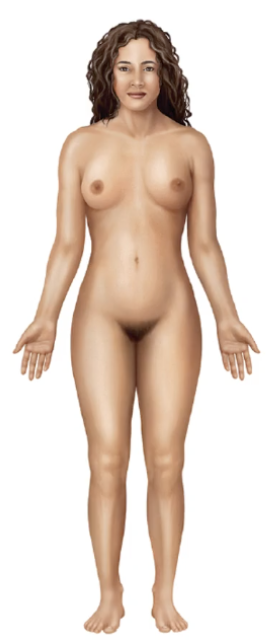A&P Chapter1
1/86
There's no tags or description
Looks like no tags are added yet.
Name | Mastery | Learn | Test | Matching | Spaced |
|---|
No study sessions yet.
87 Terms
“cutting up”
Anatomy means __ or examining structures
“relationship to nature_
Physiology means ___ or function of body parts
anatomical structure
__ allows for function
cell
atom → molecule → macromolecules → __ → tissue → organ → organ system → organism
atoms
ALL materials, living or non-living, are composed of chemicals, which consist of __
subatomic particles
protons, neutrons, and electrons that make up cells
atom
tiny particles that make up chemicals (hydrogen, carbon)
molecule
particles consisting of atoms joined together (water, glucose)
macromolecule
large particles consisting of molecules (DNA, protein)
organelle
functional part of a cell (mitochondrion, lysosome)
cell
basic unit of structure and functions (muscle, nerve, or blood cell)
tissue
layer or mass of cells with specific function (adipose or epithelial tissue)
organ
group of different tissues with function (heart, kidney, stomach)
organ system
group of organs with common function (digestive system)
organism
composed of interacting organ system (human)
cells
ALL living things consist of __
internal environment
environment within body
homeostasis
maintenance of constant internal environment
interdependency of cells
cells depend on eachother
structure and function
__ are interrelated
gradients and permeability
substances move from high to low, down pressure and concentration gradients, across permeable membranes
cellular differentiation
specialization of cells due to gene expression
cell membrane mechanisms
determine the entry of substances in response to signals
cell-to-cell communication
via membrane receptors
feedback loops
homeostatic mechanism for stability
balance
replacement of lost substances, elimination of excesses
energy
__ processes keep the cell active
reproduction
body functions and structures are working in a way to maintain life, except for __
species
reproduction perpetuates the __
metabolism
The sum of all chemical reactions in a living system
water
what is the most abundant substance in the body?
intracellular and extracellular fluids
water is the environment for metabolic processes such as __
body temp
water is required for the transport of substances and regulates __
food
__ provides necessary nutrients to supply energy
oxygen
__ releases energy from food
heat
__ partly controls the rate of metabolic reactions
atmospheric pressure
__ is important for breathing
hydrostatic pressure
__ keeps blood flowing
stimulus
__ is known when a change occurs in the internal environment of homeostatic mechanisms
control center
__ is when the change is compared to the set point in homeostatic mechanisms
effectors
__ is known as a muscle or a gland and is the result when the change is corrected in homeostatic mechanisms
negative feedback loops
__ are ongoing feedback loops (getting to a normal body temp)
positive feedback loops
__ are very short-lived feedback loops (contractions during labor)
axial portion
head, neck, and trunk of the body
appendicular portion
upper and lower limbs of the body
cranial cavity, vertebral canal, thoracic cavity, and abdominopelvic cavity
major body cavities of the axial portion is :
abdominopelvic cavity
__ cavity contains abdominal and pelvic viscera
diaphragm
__ separates the thoratic and abdominopelvic cavities
mediastinum
__ region between the lungs in the thoracic cavity, which contains the heart, esophagus, trachea, and thymus gland
orbital
__ cavity contains eyes, skeletal muscles, and nerves
tympanic
__ cavity contains the middle ear bones
serous membranes
The thoracic and addominopelvic cavities are lined by double layered __
serous fluid
serous membranes secrete __
cavity
serous fluid occupies the potential space between the layers, which is called the __
visceral layer
the inner layer of the serous membrane that covers an organ
parietal layer
the outer layer which lines the wall of the cavity
body covering (hair, nails, skin, etc.)
integumentary systems is known as the __
skeletal and muscular system
__ support the movement of the body
nervous and endocrine system
__ integrate and coordinate the body
cardiovascular and lymphatic system
__ transport things within the body
digestive, respiratory, and urinary systems
__ absorb nutrients and excrete waste within the body
anatomical position
standing erect, face forward, upper limbs at the side, palms forward

superior
above another part
inferior
below another part
anterior
toward the front
posterior
toward the back
medial
closer to the midline
lateral
away from the midline
bilateral
paired structures one on each side of the midlines
ipsilateral
structures on the same side
contralateral
structures on the opposite side
proximal
a part closer to a point of attachment to the trunk than another body part
distal
a part is farther from a point of attachment to the trunk
superficial
near the surface
deep
more internal parts
sagittal
lengthwise cut that divides the body into right and left portions
transverse
a cut that divides the body into superior and inferior positions
frontal
refers to a section that divides the body into anterior and posterior portions
cross section
a cut across the structure
oblique section
angular cut
longitudinal section
lengthwise cut
epigastric region
upper middle region of the stomach
right and left hypochondriac regions
right and left sides of the epigastric regions of the stomach
umbilical region
the central portion of the stomach
right and left lateral regions
on the right and left side of the umbilical regions of the stomach
pubic region
the lower middle region of the stomach
right and left inguinal regions
on the left and right sides of the pubic region of the stomach